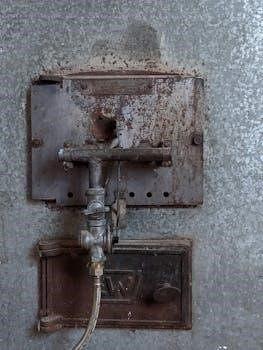Rough Country Air Bag Installation⁚ An Overview
Rough Country Air Spring kits are designed to level your vehicle when towing or hauling, reducing trailer tongue weight․ These kits feature easy, secure installation with durable, powder-coated steel brackets and push-to-connect air fittings․ They include internal bump stops for added support and safety․
Rough Country Air Spring Kits represent a significant upgrade for vehicles frequently engaged in towing or hauling․ These kits are engineered to provide enhanced load support and leveling capabilities, addressing the common issue of rear-end sag when carrying heavy loads․ The primary function of these air spring systems is to maintain a level vehicle stance, which not only improves safety and handling but also reduces strain on the vehicle’s suspension components․ By using air pressure to adjust the suspension, these kits offer a versatile solution that can be easily customized to accommodate different load weights․ The kits incorporate a double convoluted airbag design known for its durability and performance․ They are designed to be a comprehensive solution, including all necessary brackets, air lines, and fittings for a complete installation․ These kits are essential for anyone looking to optimize their vehicle’s load carrying capabilities and ensure a safer, more comfortable driving experience․
Essential Components of the Kit
A typical Rough Country Air Spring Kit includes several key components designed for a seamless and effective installation․ The core of the system consists of two high-quality, double convoluted air bags, providing the necessary lift and support․ These air bags are built with internal bump stops, adding an extra layer of protection and stability․ Durable, powder-coated steel brackets are included, serving as the mounting points for the air bags to the vehicle’s frame and axle․ These brackets are designed for specific vehicle models to ensure a secure and precise fit․ The kit also features push-to-connect air fittings, simplifying the air line connections and ensuring a leak-free seal․ Included DOT-approved air lines connect the air bags to the compressor or inflation valves, allowing for easy air pressure adjustments․ The kit often includes all necessary hardware such as bolts, washers, and nuts․ Depending on the kit, it may also include a cradle kit for enhanced suspension cycling and an onboard compressor kit for convenient air pressure adjustments․ These components work together to provide a reliable and efficient air spring system;

Step-by-Step Installation Guide
Installing a Rough Country Air Bag kit involves careful preparation, mounting of brackets, and connecting air lines․ Proper hardware checks and following instructions are crucial for a successful and safe installation․ The process is designed for ease of use․

Preparation and Hardware Check
Before beginning the installation of your Rough Country Air Spring kit, meticulous preparation and a thorough hardware check are essential․ Start by carefully unpacking all components and comparing them against the provided kit contents list․ This step ensures that you have all necessary parts and are familiar with their intended locations․ Verify the presence of brackets, bolts, push-to-connect air fittings, air lines, and the air springs themselves․ Pay close attention to any specific bolts or fasteners identified in the instructions, noting their sizes and quantities․ It is imperative to understand how each component works together to ensure a smooth installation process․ Ensure all surfaces are clean and free from any debris, paint, or rust that might interfere with proper mounting․ Having a well-organized workspace and the correct tools will streamline the installation; If you find any parts are missing or have any questions, contact Rough Country’s customer support for assistance before proceeding․ This initial check is vital for a problem-free installation․
Mounting the Upper and Lower Brackets
The process of mounting the upper and lower brackets is a critical step in the Rough Country air bag installation․ Begin by attaching the upper bracket to the air bag using the specified 3/8 x 3/4 flat head bolts, utilizing a 7/32 Allen wrench for tightening․ Ensure the bracket is securely fastened before proceeding․ Next, position the lower bracket and align it with the designated mounting points on your vehicle’s axle or frame․ Depending on your vehicle model, you may use the stock bolts or supplied hardware for this step․ Ensure that both the upper and lower brackets are aligned correctly to ensure proper operation of the air spring․ Double-check that all bolts are tightened to the manufacturer’s specified torque to prevent any movement or loosening during use․ Proper bracket alignment is crucial for the air bag to function correctly and maintain vehicle stability․ The air bag cradle kit, when installed, replaces the hard mount, allowing the suspension to fully cycle․ Recheck the alignment after installation and adjust if necessary․
Connecting Air Fittings and Air Lines
After the brackets are securely mounted, the next step involves connecting the air fittings and air lines․ Begin by installing the 90-degree fitting into the top of the air bag using a 9/16 wrench, ensuring it is properly tightened to prevent any air leaks․ Next, take the DOT-approved air lines included in your Rough Country kit and connect them to the push-to-connect fittings․ Ensure the air lines are fully inserted into the fittings for a secure, leak-free connection․ Route the air lines carefully, avoiding any sharp edges or moving parts that could damage them․ If needed, use the supplied cutter to trim the air lines to the appropriate length for your installation․ The goal is to create a clean, secure, and reliable air line system․ These connections are crucial for the proper functioning of the air bags, enabling you to adjust the air pressure as needed for load support and leveling․ Double check all connections to ensure they are secure and free from any kinks or twists before proceeding․

Post-Installation Procedures
After installation, adjust air pressure to achieve desired vehicle leveling․ Properly route compressor air lines, avoiding damage․ Ensure all connections are secure and leak-free for optimal system performance, and follow instructions thoroughly․
Adjusting Air Pressure
After the physical installation of your Rough Country air bag system, fine-tuning the air pressure is crucial for optimal performance and safety․ The ability to adjust the air pressure is what allows these systems to effectively level your vehicle when towing or carrying heavy loads․ Start by consulting the manufacturer’s recommended air pressure settings for your specific vehicle and load․ These recommendations are usually provided in the kit’s instructions, but it’s important to understand that these are just starting points․ You’ll need to make adjustments based on your unique needs and the amount of weight you’re carrying․
For instance, if you’re towing a trailer, you’ll likely need to increase the air pressure to level your vehicle and reduce stress on your suspension․ Conversely, when your vehicle is unloaded, you may need to reduce the pressure to ensure a comfortable ride․ It is best to add air in small increments, checking the vehicle’s level frequently; Typically, you should use a reliable air compressor to inflate the air bags, and a quality air pressure gauge to monitor the amount of air added to the system․ Remember, it’s always better to start with lower pressure and then add more as needed, avoiding over-inflation, which can damage the air bags․ Continually check and adjust the pressure as needed to maintain proper vehicle leveling․
Routing Compressor Air Lines
Properly routing the compressor air lines is crucial for the longevity and effectiveness of your Rough Country air bag system; The air lines connect your air bags to the compressor, allowing you to adjust air pressure․ Careful attention must be paid to the routing process to avoid kinks, abrasions, and exposure to extreme temperatures․ Begin by planning a route that keeps the lines away from hot exhaust components, sharp edges, and moving parts․ Use the provided clips and ties to secure the lines along the vehicle’s frame, avoiding any areas that could potentially pinch or damage them․
When running the lines, make sure to allow enough slack to accommodate suspension movement without pulling or stressing the connections․ If trimming is needed, use the supplied cutter in the kit to ensure a clean, straight cut․ Always ensure that the connections at both the air bags and the compressor are tight and secure, preventing air leaks․ It is best to use DOT-approved air lines, which are designed for the pressure and environmental conditions involved in automotive air suspension․ Once the routing is complete, double-check all connections and lines for any potential issues before finalizing the installation, ensuring a safe and reliable system․

Additional Considerations
When installing Rough Country air bags, consider using air bag spacers for optimal functionality․ Troubleshooting and support are available․ Also, remember the benefits of using air bags, such as improved load carrying․
Air Bag Spacers and Their Importance
When equipping your vehicle with an air bag system, incorporating an airbag spacer is crucial for achieving the desired functionality․ These spacers play a vital role in ensuring that your new system operates at its optimal level, especially when dealing with varying loads and conditions․ Rough Country recognizes the significance of these components and provides them as part of their commitment to a complete and effective installation․ The use of spacers can help to maintain proper alignment and prevent overextension of the air bags, which could lead to premature wear or damage․ By providing the necessary clearance, spacers contribute to a longer lifespan for your air bag system․ Moreover, they ensure that your vehicle maintains a level ride height, whether you are hauling heavy loads or driving under normal conditions․ This contributes to improved handling, stability, and overall safety․ Air bag spacers also help to tailor the system to your specific vehicle and its intended use․ They allow for fine-tuning of the system, so it is not only functional but also comfortable and efficient․ The inclusion of these spacers showcases Rough Country’s commitment to providing high-quality and complete solutions for your vehicle’s suspension needs․
Troubleshooting and Support
Encountering challenges during or after installation is not uncommon, and Rough Country offers resources for troubleshooting and support․ Before beginning the installation, thoroughly review the provided instructions, as this can prevent many common issues․ A crucial step is to verify that all kit components are present and accounted for before starting the project․ If any questions arise or if you encounter difficulties, Rough Country provides a direct support line at 1-800-222-7023․ This dedicated support is available to guide you through any confusing steps or offer solutions to potential problems․ Additionally, it is essential to follow the guidelines to ensure the system is correctly assembled․ Pay close attention to the proper routing of air lines, as incorrect routing can lead to leaks or damage․ In the event of any issues, always check the connections and fittings to ensure they are secure and airtight․ If you notice any unusual noises or performance issues after installation, consult the support resources․ The Rough Country team is prepared to assist with a range of problems, from basic setup issues to more complex problems, ensuring a smooth and successful installation experience․ Their commitment to customer satisfaction means they are dedicated to helping you resolve any issues with your air bag system․
Benefits of Using Rough Country Air Bags
Rough Country air bags offer a multitude of benefits, primarily focused on enhancing vehicle stability and load-carrying capabilities․ By leveling the vehicle when towing or hauling, these air bags significantly improve handling and reduce the strain on the vehicle’s suspension system․ This is particularly important when dealing with heavy loads that can cause the vehicle to sag at the rear, creating an unsafe and uncomfortable driving experience․ The adjustability of air pressure allows for a tailored ride, adapting to various load conditions to maintain proper vehicle height and alignment․ This increased stability leads to improved braking performance and reduced tire wear, resulting in enhanced overall safety and long-term cost savings․ Furthermore, the use of air springs can minimize the impact of bumps and uneven surfaces, offering a smoother and more comfortable ride․ The internal bump stop feature in Rough Country air bags provides added protection, preventing damage to the suspension components during heavy use․ The easy installation process, using durable, powder-coated steel brackets, ensures a secure and lasting setup, making Rough Country air bags a reliable and beneficial upgrade for any vehicle owner who frequently hauls or tows heavy loads․
